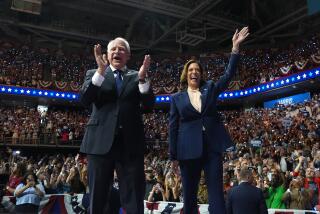THE CHARACTER ISSUE
IT’S one of the most visible choices Sen. Barack Obama has made, and it’s burning up the blogosphere and YouTube, being debated on the radio, even parodied.
It’s a typeface, of all things, one called Gotham that the Illinois Democrat chose for his rally banners and campaign signage, a collection of letter shapes some typographers are calling the hot font of 2008.
Though a discussion of fonts may seem obscure, anyone who has agonized over the look of a wedding invitation or spent hours sweating over a resume knows that letters can say nearly as much about a person as the words they spell out. And now that we are in the computer age, the message conveyed by a font is no longer subliminal, it’s overt.
“We see type as the clothes that words wear,” typographer Tobias Frere-Jones said. “You have more than one outfit in your closet, because you don’t wear the same thing to the office that you’d wear to the beach.”
Typefaces with big round O’s and tails are considered more friendly, whereas linear fonts evoke overtones of “rigidity, technology and coldness,” according to British psychologist Dr. Aric Sigman who published a 2001 study, “The Psychology of Fonts.”
With artistic flourishes such as a tail on a lowercase “a,” serif styles “conjure images of trustworthiness,” whereas uncluttered sans serif styles “carry less emotional baggage,” he says.
The serif typeface used in Sen. Hillary Rodham Clinton’s “Hillary for President” logo is New Baskerville, which is commonly used by book publishers, law firms and universities. The New York Democrat’s choice has its roots in a 1757 typeface designed by John Baskerville in Birmingham, England.
Sen. John McCain’s sans serif Optima is more recent, created in 1958 by Hermann Zapf (who, like the Arizona Republican, was once a POW). Simon Daniels, lead program manager of fonts for Microsoft’s typography team, describes it as “classic, quirky, elite and just a bit old-fashioned” -- adjectives that dovetail with the candidate’s cultivated image as a maverick.
Daniels noted, in addition to its role as a favorite of pharmaceutical packaging (Alka-Seltzer, for example) and hospital signage, one poignant and high-profile use of the typeface. “It’s the same one used to engrave the names into the Vietnam Veterans Memorial Wall,” he said. “An interesting coincidence.”
But it’s Obama’s sans serif Gotham that’s been getting all the attention. Just seven years old, the font that appears on Obama’s signs and rally banners proclaiming “Change We Can Believe In” and “Stand for Change” has a vague familiarity to it, as if plucked from an Ed Ruscha painting or from the sign atop a building you might pass by every day but never really noticed. (Obama’s logo itself is rendered in a font called Requiem -- described on the designers’ website as celebrating “the fertile world of Renaissance humanism,” whatever that means.)
John D. Berry, author of a series of books on typography, calls Gotham the font of 2008. “It’s the hot one,” he said. In a discussion of presidential branding on NPR’s “On the Media,” Gotham garnered praise for looking classy and clean with one commentator likening it to an Armani suit. Online, typography blogs are full of love letters to the typeface, and one artist created a spitting image parody of an Obama sign declaring: “Gotham, a Font We Can Believe In.”
“It’s funny to see it used in a political campaign because on the one hand it’s almost too ordinary, yet that’s the point,” Berry says. “It has that sense of trustworthiness because you’ve seen it everywhere.”
Gotham’s roots
Berry also noticed something else. “There is plenty of space between the letters, which makes all the difference in the world -- especially if you are viewing it at an angle. People are viewing these signs not just from the straight-on camera angle.”
Gotham was originally commissioned by GQ magazine and designed by Frere-Jones of the New York-based Hoefler & Frere-Jones type foundry. “They wanted a look that was masculine and fresh yet versatile,” he said, noting that the font was ultimately inspired by the Eighth Avenue Port Authority Bus Terminal sign in New York City.
Frere-Jones is also struck by the consistency of the visuals in the Obama campaign. “When you see a crowd of Obama supporters, any sign that’s not handmade is in Gotham,” he said. “I’ve never once seen a sign that’s in Arial, Helvetica or Comic Sans.”
But even the slickest new typeface can get you only so far. Just ask former Sen. John Edwards (D-N.C). His candidacy is long gone, but his campaign logo is still out there in cyberspace at www.johnedwards.com.
It’s in Gotham too.
--



